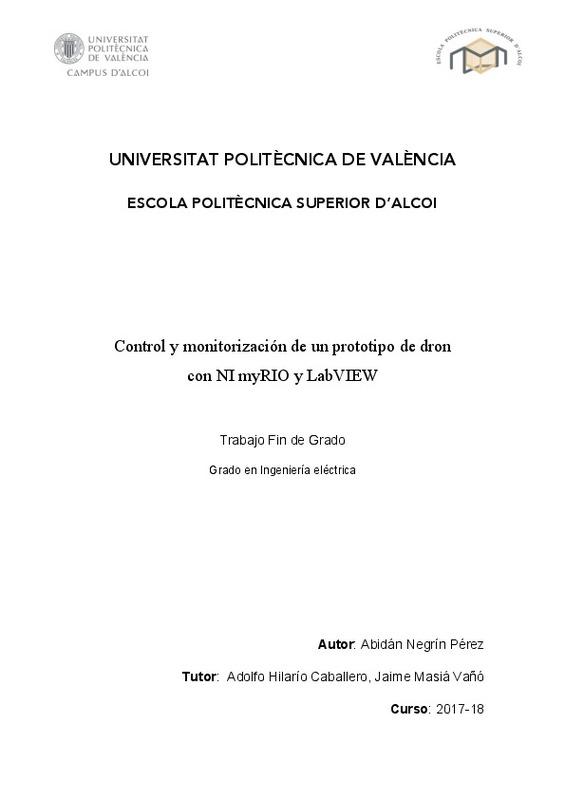JavaScript is disabled for your browser. Some features of this site may not work without it.
Buscar en RiuNet
Listar
Mi cuenta
Estadísticas
Ayuda RiuNet
Admin. UPV
Control y monitorización de un prototipo de dron con NI myRIO y LabVIEW
Mostrar el registro sencillo del ítem
Ficheros en el ítem
| dc.contributor.advisor | Masiá Vañó, Jaime
|
es_ES |
| dc.contributor.advisor | Hilario Caballero, Adolfo
|
es_ES |
| dc.contributor.author | Negrín Pérez, Abidán
|
es_ES |
| dc.date.accessioned | 2019-01-14T12:27:50Z | |
| dc.date.available | 2019-01-14T12:27:50Z | |
| dc.date.created | 2018-09-24 | |
| dc.date.issued | 2019-01-14 | es_ES |
| dc.identifier.uri | http://hdl.handle.net/10251/115401 | |
| dc.description.abstract | [ES] Ahora que los drones están en auge y están empezando a ser bastante comunes por una parte por sus numerosas aplicaciones, por otra parte el abaratamiento de los componentes y por la facilidad de unir algunos componentes que incluso los aficionados son capaces de volar y construir drones. La tecnología usada en base a estos vehículos aéreos se a puesto al alcance de la mano es la aplicación del IMU en los teléfonos móviles esto ha hecho que el sistema de navegación de estas aeronaves hayan bajado también. Esta alza ha sido bastante notoria para nosotros, por lo que hemos querido aprender más acerca del funcionamiento de los drones. Para un estudiante de ingeniería eléctrica, el interés principal se encuentra en la inteligencia detrás de estas máquinas. Por ello, pensamos que la mejor manera de descubrirlo sería intentar programar uno por nuestra cuenta. A través de varias investigaciones y aplicar lo que aprendimos, conseguimos programar un dron usando los programas LabVIEW, MATLAB y Simulink. En esta memoria hablaremos sobre: los conceptos básicos de los drones, sistemas de control, cómo funciona la legislación al respecto en Europa y España así cómo hemos programado nuestro dron. Igualmente, compartiremos aspectos a tener en cuenta mientras se usan estos drones y en especial, la inteligencia de la que los drones están compuestos. | es_ES |
| dc.description.abstract | [EN] Now that drones are on the rise, they are starting to be quite common. Its numerous applications, the cheapening of their components and the ease of joining most of the components are the main reasons why even fans and hobbyist are able to fly and build their own drones. Concerning to its cheapining, there is a fact that must be mentioned. The technology used in these aerial vehicles is the same that is being used in mobile phones, which is IMU. As IMU has become crucial to the mobile phone operative, this has also meant a considerable price drop. This upswing has been quite remarkable for us, so we wanted to learn more about how drones work. For us, as students in electrical engineering, the main interest lies in the intelligence behind these machines. Therefore, we thought that the best way to learn about the intelligence of the drone was to try to program one by ourselves. Through various investigations and applying what we learned, we managed to program it using the programs LabVIEW, MATLAB and Simulink. In this report, we will talk about: the basic concepts of drones, control systems, what the legislation is in Europe and Spain and how we programmed our drone. Likewise, we will share some aspects to keep in mind while we use these drones and in particular, the intelligence of which the drones are composed. | es_ES |
| dc.format.extent | 81 | es_ES |
| dc.language | Español | es_ES |
| dc.publisher | Universitat Politècnica de València | es_ES |
| dc.rights | Reserva de todos los derechos | es_ES |
| dc.subject | Quadcopter | es_ES |
| dc.subject | Cuadricóptero | es_ES |
| dc.subject | Dron | es_ES |
| dc.subject | Control avanzado | es_ES |
| dc.subject | NI myRIO | es_ES |
| dc.subject | LabVIEW | es_ES |
| dc.subject | Matlab | es_ES |
| dc.subject | Simulink | es_ES |
| dc.subject | Drone | es_ES |
| dc.subject | Advance Control | es_ES |
| dc.subject.classification | INGENIERIA MECANICA | es_ES |
| dc.subject.classification | INGENIERIA DE SISTEMAS Y AUTOMATICA | es_ES |
| dc.subject.other | Grado en Ingeniería Eléctrica-Grau en Enginyeria Elèctrica | es_ES |
| dc.title | Control y monitorización de un prototipo de dron con NI myRIO y LabVIEW | es_ES |
| dc.type | Proyecto/Trabajo fin de carrera/grado | es_ES |
| dc.rights.accessRights | Abierto | es_ES |
| dc.contributor.affiliation | Universitat Politècnica de València. Instituto Universitario de Automática e Informática Industrial - Institut Universitari d'Automàtica i Informàtica Industrial | es_ES |
| dc.contributor.affiliation | Universitat Politècnica de València. Escuela Politécnica Superior de Alcoy - Escola Politècnica Superior d'Alcoi | es_ES |
| dc.contributor.affiliation | Universitat Politècnica de València. Departamento de Ingeniería Mecánica y de Materiales - Departament d'Enginyeria Mecànica i de Materials | es_ES |
| dc.contributor.affiliation | Universitat Politècnica de València. Instituto de Diseño para la Fabricación y Producción Automatizada - Institut de Disseny per a la Fabricació i Producció Automatitzada | es_ES |
| dc.contributor.affiliation | Universitat Politècnica de València. Departamento de Ingeniería de Sistemas y Automática - Departament d'Enginyeria de Sistemes i Automàtica | es_ES |
| dc.description.bibliographicCitation | Negrín Pérez, A. (2018). Control y monitorización de un prototipo de dron con NI myRIO y LabVIEW. http://hdl.handle.net/10251/115401 | es_ES |
| dc.description.accrualMethod | TFGM | es_ES |
| dc.relation.pasarela | TFGM\66670 | es_ES |
Este ítem aparece en la(s) siguiente(s) colección(ones)
-
EPSA - Trabajos académicos [5826]
Escuela Politécnica Superior de Alcoy






